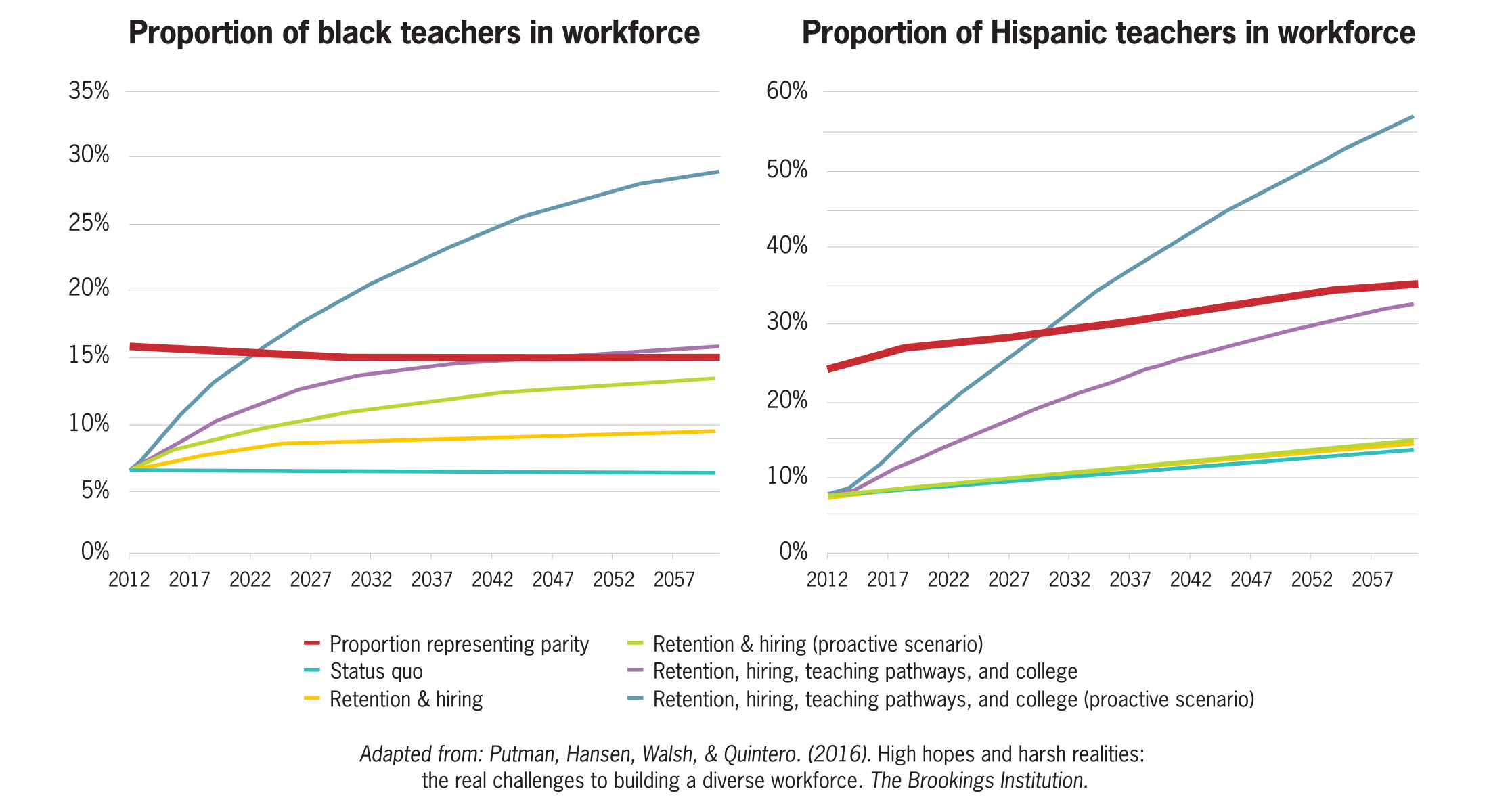One feature of an ideal school environment, we believe, is that both students and their teachers reflect America in all of its diversity. Everyone, including children coming from privilege, benefits from a diverse school experience.
It’s no wonder that as the minority student population has grown in numbers in the past few decades, surpassing 50 percent, so many of us are troubled that the minority teacher population has failed to keep pace, standing now at only 18 percent minority. The push to achieve racial parity between teachers and students has never been stronger, with urgent calls from school boards, states, and even the U.S. Department of Education for the nation to make teacher diversity a top goal for school districts.
This sentiment is understandable, commendable, but — at the risk of being a wet blanket — not even remotely achievable within the foreseeable future.
No matter how you run the numbers, school districts simply cannot recruit and retain enough black and Hispanic teachers to achieve racial parity between the teacher workforce and the U.S. student body – no matter how many reprimands HR officials have to face from the their school boards for the paltry results.
Researchers from NCTQ and The Brookings Institution recently analyzed what it would take to create a teaching workforce as diverse as the students it serves. You can find a full report of our analysis and findings here.
We estimate the effects of different interventions that might increase the number of minority teachers, extrapolating population projections for the next four decades to see how close they can come to creating a racially representative teacher workforce.
The findings are startling: parity or even significant inroads to parity will remain completely elusive unless we fire on all cylinders. If we can somehow boost the rates of college completion, interest in teaching, hiring, and retention so that these rates for black and Hispanic college students and adults mirror the rates of their white counterparts, then parity becomes an achievable goal – but is still several decades away.
How can this be?
Let’s walk through what we found, drawing on a model we built using U.S. Census projections and data about the current teacher and student populations to estimate the impact of various interventions.
For example, let’s see where a big push on retention of black teachers gets us. Currently, 16 percent of America’s public school students are black, compared to 7 percent of teachers, creating a nine percentage point gap in the diversity of students and teachers.
What could happen if schools took real and substantive steps to retain their black teachers so that year in and year out black teachers stay in the classroom at the same rate as white teachers (improving their current attrition rate from 10 percent to mirror white teachers’ 7 percent)? We still wouldn’t close the diversity gap even projecting out to 2060 (the furthest year of Census projections available).
Next, imagine we committed ourselves heart, body, and soul (as many districts are, in fact, trying to do) to hire more black teachers. The rewards would be tiny even projecting all the way out to 2060.
Okay, so what about persuading more black college students to consider teaching? Higher education could heavily promote teaching with undergraduates, or graduate programs and alternative providers could recruit more black candidates—something that many claim to be doing already.
But let’s imagine pouring some real resources into these strategies, such as increased salaries, loan forgiveness, or more leadership opportunities to succeed in persuading black adults to consider teaching at the same rate as white adults (currently 4.3 percent of black undergraduate students major in education compared with 6.9 percent of white undergraduates; we see similar disparities for graduate college education degrees and alternative certification enrollment).
Again, the results would be fairly paltry – closing the diversity gap by about two and a half percentage points by 2060.
I’m guessing that a lot of people reading this are thinking “but look at the success of Teach For America, now recruiting new cohorts which are about 50 percent teachers of color?” TFA was able to achieve these huge gains in part because it developed unprecedented recruitment efforts of minority students beginning in their freshmen year—a great strategy to emulate. But keep in mind that the corps is tiny compared to America’s needs. Teach For America supplies less than 3 percent of the nation’s teachers. Its hard push on this problem still only produced about 800 new black corps members in a year. That’s enough to translate into significant gains for TFA, which is only recruiting some 4,100 teachers in a year, but remains a far cry from the 300,000 more black teachers needed to achieve parity across all American schools.
Let’s go back to the point of greatest disparity between black and white students: the college completion rate. If we invest heavily to support black students and ameliorate their low college completion rate so that they graduate college at the same rate as white students (currently 28 percent of black 22-year olds have earned a bachelor’s degree, compared with 47 percent of white 22-year olds), we still will not come close to closing the gap by 2060.
Disheartening, no?
For Hispanic teachers, the dismal scenario is much the same. In fact because the Hispanic population in the US is growing at such a fast rate, much faster than the black population, the diversity gap is expected to widen if we do not take action.
Only if we are able to graduate more Hispanic teachers from college or draw more Hispanic adults into careers in teaching can we reduce the growing diversity gap significantly, otherwise expected to be 22 percentage points by 2060.
Clearly, the answer is to combine all these interventions and be successful at all of them (success defined here as achieving the same rates as their white counterparts) to make any real dent. If over the next decade we were to improve college completion rates, interest in teaching, hiring, and retention to mirror that of white teachers at every point, we would actually achieve parity by the year 2044 for black teachers and students. The picture is less cheery for Hispanic teachers, only coming within the ballpark (three percentage points away from racial parity) by consistent pushes through 2060.

So are we suggesting we all throw up our hands and give up on achieving greater parity? Absolutely not. But let’s not underestimate the ambition, commitment, and persistence needed, or browbeat school superintendents or human resources officials when they are only able to make incremental progress. Let’s also not advocate for racial parity at the expense of quality. The research is clear that students’ success still depends most on the quality of their teachers
In the meantime, other important solutions can achieve greater equity in our schools. Let’s look for meaningful ways to ensure that teachers – who want to do right by their students – don’t unintentionally do harm to the kids who don’t look like them. Let’s go beyond the stuff of current trainings in which teachers and teacher candidates engage in a lot of reflecting on their implicit biases, analyzing their white privilege, or developing cultural sensitivity, much of which hasn’t had much impact – although these do play an important role. Let’s do more to have teachers examine their daily interactions with students by asking themselves: which students do they call on to answer questions? Are some students more likely to receive harsher disciplinary actions than others? Do they select some groups of students for more challenging work over others? Give teachers the training and tools to make sure that they do not allow their biases along race, gender, class, or any other lines to get in the way of helping every child thrive.
More like this

What can California, Texas, and Washington, D.C. teach us about how to diversify the teacher workforce?

A New Roadmap for Strengthening Teacher Diversity

When “do no harm” is impossible, how can districts design teacher layoffs to do the least damage?



